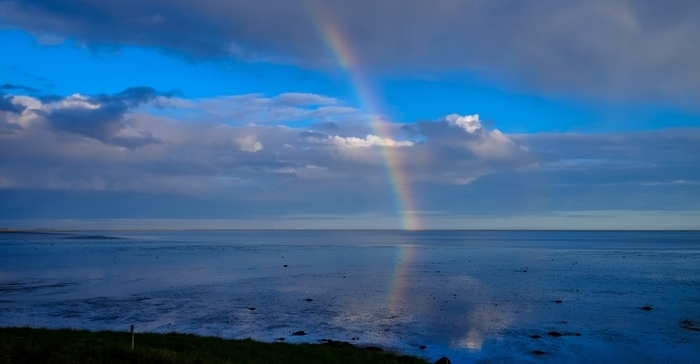CREATION AND COVENANT
by Roger Wyatt | 3rd June 2021 | more posts on
'Covenant'| 0


The concept of covenant is introduced early in the book of Genesis, although the word is not used until Genesis 9. After Noah and his sons, along with their unnamed wives, emerge from the ark, God blesses the surviving remnant of humanity with words much like those spoken to Adam and Eve generations before: ‘Then God blessed Noah and his sons, saying to them, “Be fruitful and increase in number and fill the earth”’ (Genesis 9:1). Nowhere however, in the opening chapter of Genesis, is it explicitly stated that God was instituting a covenant with the first humans. In comparison, the text of Genesis 9 outlines the terms of an agreement between God and his created order, an agreement distinctly called ‘my covenant’ בְּרִיתִי (beriti): ‘Then God said to Noah and to his sons with him: “I now establish my covenant with you and with your descendants after you”’ (Genesis 9:8-9).
The Noahic covenant is described as everlasting (for all generations) and as encompassing the whole of the created order: ‘And God said, “This is the sign of the covenant I am making between me and you and every living creature with you, a covenant for all generations to come: I have set my rainbow in the clouds, and it will be the sign of the covenant between me and the earth”’ (Genesis 9:12-13). In many ways, the terms of the covenant read as a development of the words spoken to Adam and Eve; the latter contains one prohibition, to not eat from the tree of the knowledge of good and evil, whilst the former contains two – it both forbids the eating of meat with the blood not drained from it, and the taking of another human life (two rudimentary prohibitions of the later Levitical code and the Mosaic law). Indeed, although the words spoken by God in Genesis 1 are not labelled as covenantal, they reflect many of the same elements as the Noahic covenant: they contain a blessing, a prohibition, a promise of provision, and a commission to rule. And in this way, all the language of Genesis 1-2 suggests something covenantal is being articulated by God. However, unlike the Noahic covenant, which is accompanied by the sign of a rainbow, there is seemingly no explicit mention of a sign in Genesis 1-2. In what sense then can the first two chapters of Genesis constitute a true covenant between God and humanity? In fact, although not explicitly linked to the primeval agreement, it may well be that there was not one, but two signs of the Edenic covenant, described in verse fourteen: ‘And God said, “Let there be lights in the vault of the sky to separate the day from the night, and let them serve as signs to mark sacred times, and days and years”’. The NIV translation somewhat obscures a straightforward statement: וְהָיוּ לְאֹתֹת וּלְמוֹעֲדִים וּלְיָמִים וְשָׁנִֽים (wehayu leotot ulemowadim uleyamim wesanim lit. and let them be for signs and seasons for days and years). That is, the sun and moon are not ‘signs to mark sacred times’, but more simply just ‘for signs’, an assertion semantically different from ‘for seasons’.
Intertextually, there are some further indications that the words of Genesis 1-2 to Adam and Eve do, indeed, constitute part of a wider covenantal agreement between God and the created order. In Jeremiah 33 Yahweh speaks through the prophet saying, ‘If you can break my covenant with the day and my covenant with the night, so that day and night no longer come at their appointed time then . . .’ (Jeremiah 33:20-21). In this chapter the covenant is listed alongside three other inviolable and everlasting covenants, the Aaronic, Davidic and Abrahamic, and as such it is perhaps inferred that God’s covenant with the day and the night should take its rightful place as one of the central covenants of the Old Testament. Verse twenty five expands the thought of Yahweh through the prophet Jeremiah: ‘This is what the LORD says: “If I have not made my covenant with day and night and established the laws of heaven and earth then . . .”’ (Jeremiah 33:25-26). And so, it seems highly likely that Jeremiah’s reference to the covenant with the day and night, alludes to the very first day of creation, in which ‘God called the light “day,” and the darkness he called “night.” And there was evening, and there was morning—the first day’ (Genesis 1:5). Moreover, the reader is quick to think of Genesis 1 when Jeremiah mentions the establishment of the ‘laws of heaven and earth’: ‘In the beginning God created the heavens and the earth’ (Genesis 1:1).
God’s covenant with creation then, (of which his instructions to Adam and Eve form a part) relates to the natural laws that govern the universe; the day and the night, and even the physical and moral framework in which the first humans lived. In this way, God’s first covenant may be best summed up as an agreement with the whole of creation – a covenant of such a scope that the rules of the universe form part of the conditions under which the covenant operates. Jeremiah’s reference to the covenant with the day and the night then, should be understood as a pointer to the first covenant, by synecdoche. Moreover, by naming it so, Jeremiah draws further attention to the fact that the ‘lights in the vault’ are, almost certainly, to be understood as the signs of the covenant.
If Genesis 1-2 then does indeed constitute the very first covenant between God and his creation, the question remains to be asked, what is actually being agreed upon? Taken at face value, with its terms of promise and prohibition, the covenant embodies the means through which God’s creatures can remain in the place of blessing, purpose and provision, primarily through obedience to God’s commands. The truth of this is illustrated when the consequences of the disobedience to the first prohibition are felt; when Adam and Eve ate the forbidden fruit, they came out from under the covering of the covenant, were expelled from the place of blessing, and needed a new type of covering which required the shedding of blood – foreshadowing the coming of the Levitical code. Quite simply, for those born after the fall, without the covering of sacrifice, the terms of the covenant no longer applied, and moral and spiritual chaos ensued, prompting judgement.
By the time of Noah then, a different covenant was required, for the first had failed. Now, the sign of the promise of the blessing was no longer the sun and moon, but a rainbow in the firmament, encapsulating a promise of comfort after judgement. In fact, as has already been noted, the second covenant represents more of a restatement, and redevelopment of the first covenant, rather than a new covenant. This development includes a greater permissiveness but also a greater degree of prohibition, foreshadowing something of later developments to the covenant. Finally, if the Edenic covenant is, by synecdoche, pointing to the first day of creation, the Noahic covenant, fashioned after the great flood, is identified with a different realm to that of day one and now references the realm of the firmament, and the second day of creation; the very arena in which the pre-flood world was brought to an abrupt end:
‘And God said, “Let there be a vault between the waters to separate water from water.” So God made the vault and separated the water under the vault from the water above it. And it was so. God called the vault “sky.” And there was evening, and there was morning—the second day.’ (Genesis 1:6-8)
And so, it seems that the first two covenants of the Old Testament are prefigured by the first two days of the creation narrative. The first covenant reveals the totality of God’s plan for humanity, for them to exist in a state of blessing yet to be fully revealed, signified by the sun and the moon which ‘separate light from darkness’ (Genesis 1:18). The second delineates something of the first and offers up more moral and spiritual pointers to help contain the new force of sin at work in the world, and is signified by a rainbow. In that regard, the first two covenants speak into the realities of good and evil (light and darkness), and judgement and salvation (flood and rescue). However, in the end, the commission to rule and keep the terms of the covenant could not be kept by the descendants of Noah, and a better covenant would again be required; a covenant, the sign of which was to be cut into the very flesh of one of Noah’s descendants, Abram.
